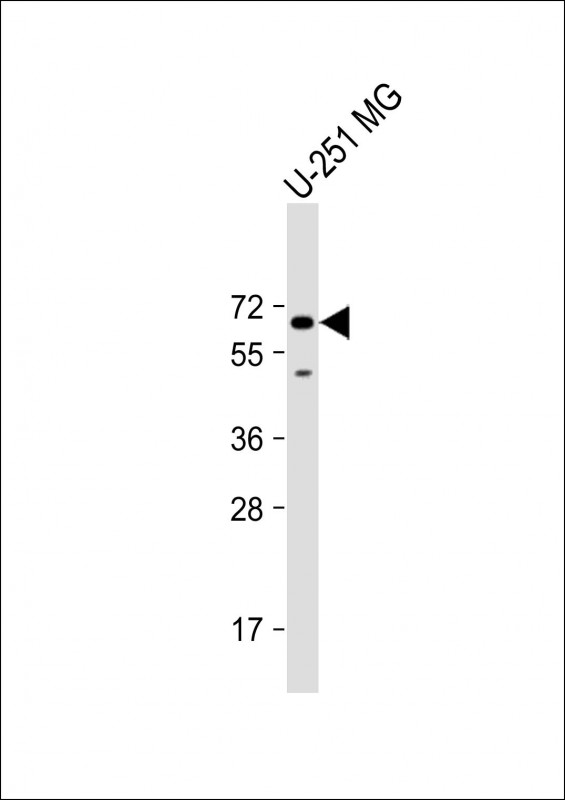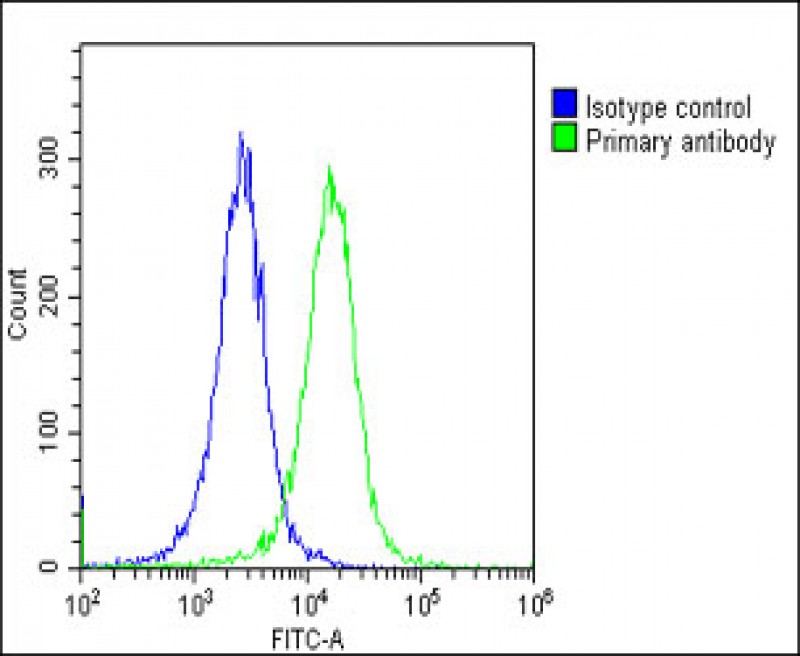

| WB | 咨询技术 | Human,Mouse,Rat |
| IF | 咨询技术 | Human,Mouse,Rat |
| IHC | 咨询技术 | Human,Mouse,Rat |
| ICC | 技术咨询 | Human,Mouse,Rat |
| FCM | 1/25 | Human,Mouse,Rat |
| Elisa | 咨询技术 | Human,Mouse,Rat |
| Aliases | SH2B adapter protein 3, Lymphocyte adapter protein, Lymphocyte-specific adapter protein Lnk, Signal transduction protein Lnk, SH2B3, LNK |
| Entrez GeneID | 10019 |
| WB Predicted band size | 63.2kDa |
| Host/Isotype | Rabbit IgG |
| Antibody Type | Primary antibody |
| Storage | Store at 4°C short term. Aliquot and store at -20°C long term. Avoid freeze/thaw cycles. |
| Species Reactivity | Human |
| Immunogen | This SH2B3 antibody is generated from a rabbit immunized with a KLH conjugated synthetic peptide between 67-101 amino acids from the human region of human SH2B3. |
+ +
1. **"SH2B3 regulates hematopoietic stem cell self-renewal and coordinates lymphoid organization"**
- **作者**: Takizawa H, et al.
- **摘要**: 该研究通过SH2B3(N-Term)抗体的免疫沉淀和Western blot分析,揭示了SH2B3在造血干细胞自我更新和淋巴系统发育中的作用,证明其通过调控JAK-STAT信号通路维持干细胞稳态。
2. **"LNK suppresses inflammatory cytokine production in macrophages through interaction with JAK2 kinase"**
- **作者**: Li Y, et al.
- **摘要**: 使用SH2B3(N-Term)抗体进行免疫荧光和共定位实验,发现SH2B3通过结合JAK2抑制巨噬细胞炎症因子释放,为炎症性疾病治疗提供潜在靶点。
3. **"Genetic and functional analyses of SH2B3 in type 1 diabetes susceptibility"**
- **作者**: Dendrou CA, et al.
- **摘要**: 通过SH2B3(N-Term)抗体的Western blot验证,结合GWAS数据,发现SH2B3基因变异与1型糖尿病风险相关,其N端结构域缺失突变导致T细胞过度激活。
4. **"SH2B3 deficiency accelerates atherosclerosis via enhanced endothelial cell apoptosis"**
- **作者**: Wang Q, et al.
- **摘要**: 利用SH2B3(N-Term)抗体进行组织免疫组化分析,证明SH2B3缺失通过上调内皮细胞凋亡促进动脉粥样硬化,机制涉及PI3K/AKT信号抑制。
以上文献均明确使用针对SH2B3蛋白N端的抗体进行功能验证,涵盖血液、免疫、代谢及心血管疾病模型,可作为该抗体应用场景的参考。
The SH2B3 (N-Term) antibody targets the N-terminal region of the SH2B adapter protein 3. encoded by the SH2B3 gene (also known as LNK). SH2B3 is a member of the SH2B family of cytoplasmic adaptor proteins, which regulate signaling pathways in hematopoietic and immune systems. The N-terminal domain of SH2B3 contains critical functional motifs, including a pleckstrin homology (PH) domain and proline-rich regions, which mediate interactions with kinases, receptors, and other signaling molecules. This antibody is commonly used to study SH2B3's role in modulating JAK-STAT, PI3K-AKT, and cytokine receptor signaling pathways, particularly in hematopoiesis, inflammation, and cellular proliferation.
SH2B3 acts as a negative regulator of growth factor and immune signaling. Its dysfunction has been linked to hematologic disorders (e.g., leukemia, myeloproliferative neoplasms), autoimmune diseases (e.g., rheumatoid arthritis), and cardiovascular conditions. The rs3184504 single nucleotide polymorphism (SNP) in SH2B3 is associated with increased cardiovascular risk and autoimmune susceptibility. Researchers employ the SH2B3 (N-Term) antibody in techniques like Western blotting, immunoprecipitation, and immunofluorescence to investigate protein expression, localization, and interaction partners in cell lines or primary cells. Its specificity for the N-terminal region allows focused analysis of SH2B3's regulatory functions, distinct from its C-terminal SH2 domain involved in phosphotyrosine-dependent interactions. Validation typically includes testing in SH2B3 knockout models to confirm target specificity.
×